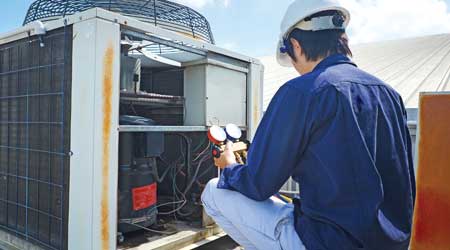 Performing routine diagnostics on building equipment can help managers determine how energy is being used within a building.
Performing routine diagnostics on building equipment can help managers determine how energy is being used within a building.HVAC: Diagnosing Energy Waste
Smart building controls enable managers and technicians to uncover and address energy waste in HVAC systems.
Today’s institutional and commercial facilities produce a treasure trove of data each day. With the help of state-of-the-art building automation systems (BAS), maintenance and operations technicians can quickly assess the health of a building with a few clicks of a mouse.
Having the current status of nearly every piece of equipment serving the HVAC system at one’s fingertips can be empowering but also overwhelming. The challenge for managers and technicians is to understand the technology and options and, most importantly, to put the data to work to produce tangible benefits for the organization.
Diagnosing trouble
Part of an effective operator’s daily routine should be to review and prioritize all of the new alarms in the BAS and to carefully scan the graphics and summary pages of major pieces of building equipment for red flags. Alarms speak for themselves in terms of importance, but depending on the sensitivity of the alarms setup by the control vendor, a substantial list of conditions can qualify as poor HVAC performance but would not necessarily trigger an alarm condition.
Similar to a doctor examining a patient, buildings have diagnostics that allow a trained operator to determine its condition. A diagnostic helps determine the cause or nature of a problem. Diagnostic paths typically have to be thoughtfully created because often, the diagnostic the operator might stumble upon could be the result of several upstream diagnostics that were missed.
For example, is the lag chiller running at low loads, or is the lead chiller surging? This could indicate low Delta-T. Why does the building have low Delta-T? Are the primary chilled-water pumps overpumping the secondary loop and returning a lot of the supply water to the chillers? In the variable-primary system, did the design engineer put too many three-way valves at the end of the loop, or did the variable-frequency drive (VFD) start-up technician set the minimum speed too high?
Establishing a thorough diagnostic path can take years of experience, but is crucial in being able to solve problems quickly. It also helps to have years of experience in the same building. This is not a luxury some facility operators have because they might have switched jobs and are now at an unfamiliar facility. Some operators cover several facilities and have varying knowledge of each facility. But even operators with many years of experience at the same facility still must deal with time constraints, which is the last hurdle to formulating effective diagnostic paths.
Operators facing problems often run short on time and use quick fixes. If the problem is hot complaints from occupants on the second floor, the quick response might be to crank down the discharge air temperature on the air handler instead of checking the variable-air volume (VAV) and thermostat in that zone for issues. The actual problems could be that somebody overrode the damper closed earlier in the year when they received a cold complaint from that area.
Logging issues
One solution that would help managers and technicians with all of the HVAC issues they encounter is a diagnostic issues log. Some control system software packages might have this feature. If not, several third-party diagnostic and tracking software applications targeting HVAC operations use the available trend data and reporting features of the BAS, which often go underused.
Using a diagnostic and tracking tool creates a central repository for common issues, which can include specific notes detailing work performed on a particular issue. After such a system has been in place for a year or more, a new operations employee can get up to speed quickly by reviewing the historical record of work performed on the various HVAC components. Managers also can incorporate it into the standard work order process.
Another situation in which a diagnostic issues log becomes extremely helpful is when a technician uses it to take the individual trends the control system already has available and customize them into HVAC systems so the operator can see many related trends at once for easier troubleshooting. With quick access to easily digestible charts containing data going back months, an operator can see patterns emerge in underperforming equipment. Hydronic coils in air handling units (AHU) that have become dirty over the years might lead to higher fan speeds and wide-open control valves at low loads.
If the operator can quickly review a chart of that AHU from one or more years ago, he or she might see that the chilled water valve historically did not get more than 50 percent open or that the speed of the VFD supply fan never rose above 45 percent but now is at 75 percent speed to deliver the same airflow. These observations or diagnostic triggers can help lead the operator to the root cause of the problem — a dirty coil or filter bank or slipping belt, for instance.
Related Topics:














